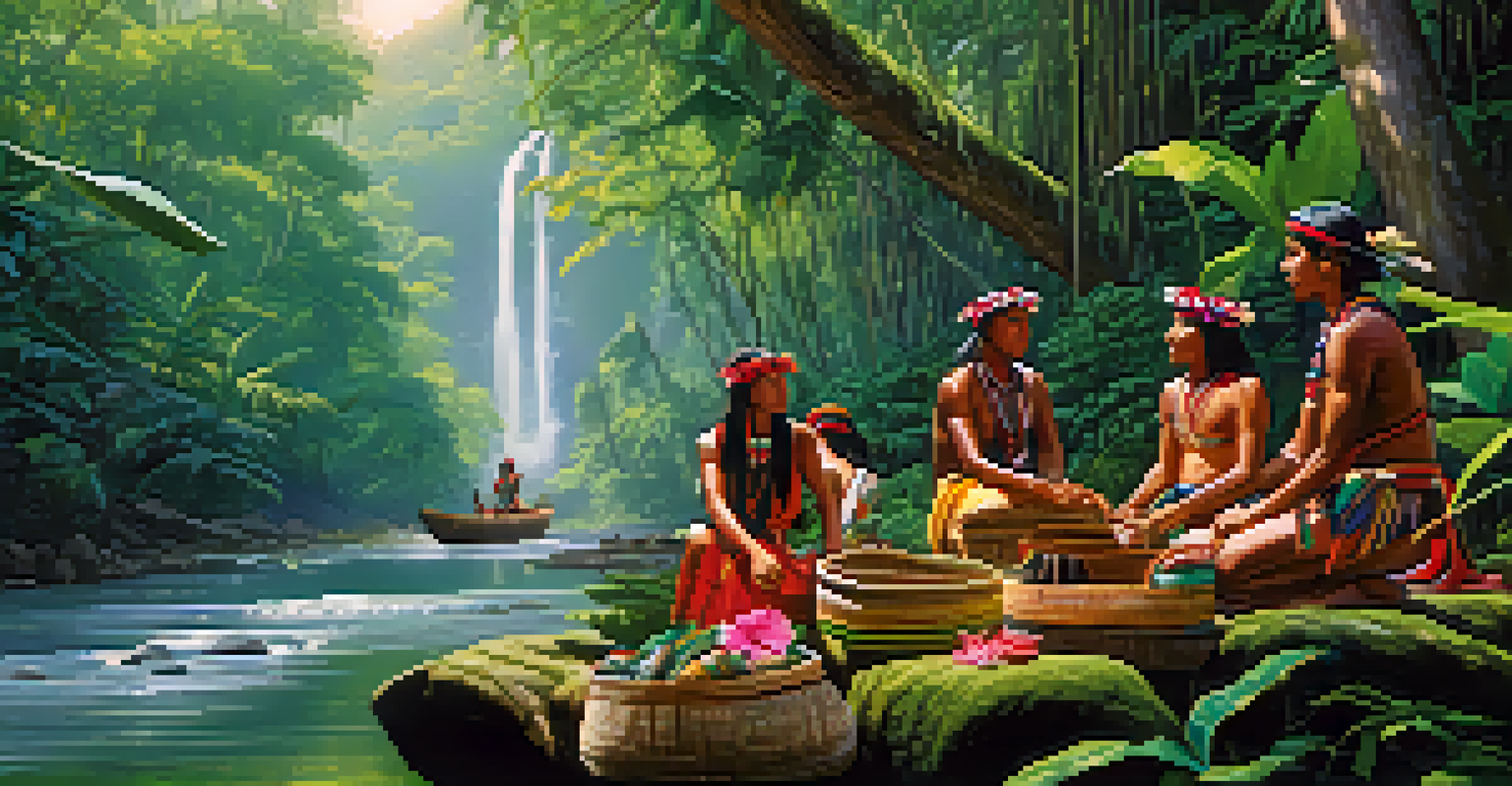The Rich Tapestry of Peru's Indigenous Languages Overview

Introduction to Peru's Linguistic Diversity
Peru is a country rich in cultural and linguistic diversity, with over 47 Indigenous languages spoken throughout its regions. This diversity is a reflection of the country's complex history and the numerous ethnic groups that have thrived here for centuries. Languages like Quechua and Aymara have deep roots in the Andes, while others, like Ashaninka, are integral to the Amazon rainforest communities. Understanding this linguistic landscape is crucial to appreciating Peru's cultural heritage.
A language is something infinitely greater than grammar and philology. It is the poetic testament of the genius of a race and the culture of a nation.
The survival of these languages is not merely about communication; it represents the identity and worldview of the Indigenous peoples. Each language carries unique stories, traditions, and knowledge that have been passed down through generations. For instance, the Quechua language is not just a means of conversation; it is a vessel of history, poetry, and spirituality.
However, the vitality of these languages faces challenges due to globalization and modernization. Many Indigenous languages are at risk of extinction, as younger generations often shift to more dominant languages, particularly Spanish. It is essential to recognize and support the efforts aimed at revitalizing these languages to preserve the rich tapestry of Peru's cultural identity.
Quechua: The Language of the Incas
Quechua is perhaps the most recognized Indigenous language in Peru, historically linked to the Inca Empire. It is spoken by millions across the Andes and has various dialects, each reflecting the distinct regional cultures. The language has survived centuries of colonial influence and continues to thrive in both rural and urban settings, showcasing its resilience and adaptability.

In recent years, there has been a resurgence of interest in Quechua, particularly among younger Peruvians. Educational initiatives and cultural programs are helping to promote the language, ensuring it remains a vital part of Peru's contemporary identity. Additionally, Quechua is now being integrated into public signage and educational curriculums, which helps to elevate its status.
Peru's Linguistic Diversity
Peru is home to over 47 Indigenous languages, each representing the rich cultural heritage and identity of various ethnic groups.
Moreover, the language is celebrated in literature and music, with numerous artists incorporating Quechua into their works. This artistic expression not only preserves the language but also fosters a sense of pride among speakers. As more people embrace their Indigenous heritage, Quechua stands as a testament to Peru's rich cultural legacy.
Aymara: Voices from the Altiplano
Aymara is another prominent Indigenous language, primarily spoken around Lake Titicaca and the highlands of Bolivia and Peru. Like Quechua, Aymara has a rich oral tradition and is deeply intertwined with the cultural practices of its speakers. The language has unique grammatical features that reflect the Aymara worldview, particularly in how it expresses time and space.
Languages are not just a means of communication; they are the carriers of culture and identity.
In the Aymara community, language plays a crucial role in social organization and cultural identity. The language is often used in rituals and traditional practices, reinforcing the connection between the speakers and their ancestors. Festivals and ceremonies frequently feature Aymara songs and stories, showcasing the language's living nature.
However, Aymara faces similar challenges as Quechua, with younger generations gravitating toward Spanish. Efforts to revitalize Aymara include bilingual education programs and community workshops that encourage the use of the language in everyday life. By fostering a sense of pride and cultural belonging, these initiatives aim to secure a future for Aymara and its speakers.
Amazonian Languages: A Lesser-Known Heritage
While Quechua and Aymara dominate discussions about Indigenous languages in Peru, the Amazon region is home to a plethora of lesser-known languages, such as Ashaninka, Shipibo-Conibo, and many others. These languages reflect the rich and diverse cultures of the rainforest communities, each with its own unique expressions and traditions. The Amazonian languages are not just means of communication; they embody the relationships these communities have with nature.
Indigenous groups in the Amazon have developed intricate knowledge systems that are woven into their languages. For example, the Shipibo-Conibo people have a profound understanding of their environment, which is intricately expressed through their language. The vocabulary and structure often include specific terms for plants, animals, and ecological phenomena, showcasing their deep connection to the land.
Challenges to Language Survival
Globalization and modernization pose significant threats to Indigenous languages, leading many younger generations to favor dominant languages like Spanish.
Sadly, many Amazonian languages are endangered due to external pressures like deforestation and cultural assimilation. However, efforts are underway to document and revitalize these languages through community-driven initiatives. By valuing and preserving Amazonian languages, we can help protect not only the linguistic diversity of Peru but also the invaluable ecological knowledge embedded within them.
The Role of Education in Language Preservation
Education plays a vital role in preserving Indigenous languages in Peru. Bilingual education programs that incorporate both Spanish and Indigenous languages are essential for fostering a sense of cultural pride and identity among young people. These programs not only teach language skills but also celebrate the rich cultural heritage associated with these languages.
Schools that prioritize Indigenous languages often see a positive impact on student engagement and academic performance. When students learn in their mother tongue, they tend to perform better and develop a stronger connection to their cultural roots. This approach helps bridge the gap between traditional knowledge and modern education, empowering students to embrace their heritage while adapting to contemporary society.
Moreover, the involvement of Indigenous communities in educational initiatives is crucial. When communities actively participate in curriculum development and teaching, it helps ensure that the language and cultural practices are authentically represented. Such collaboration can lead to innovative educational models that respect and promote linguistic diversity in Peru.
Cultural Revival Through Language
The revival of Indigenous languages in Peru is closely tied to cultural revitalization efforts. As communities work to reclaim their languages, they often engage in broader initiatives aimed at preserving traditional practices, arts, and customs. This cultural resurgence is not just about language; it encompasses a holistic approach to identity and community well-being.
Art, music, and storytelling are central to this cultural revival, with many artists and performers incorporating Indigenous languages into their work. Through various forms of expression, they celebrate their heritage and raise awareness about the importance of language preservation. This creative fusion helps attract interest from both local and global audiences, fostering a greater appreciation for Peru's Indigenous cultures.
Education's Role in Preservation
Bilingual education programs are crucial for fostering cultural pride and ensuring the survival of Indigenous languages among younger populations.
Additionally, cultural festivals and events that feature Indigenous languages serve as platforms for community pride and visibility. These gatherings highlight the richness of Peru's cultural tapestry, allowing speakers to share their stories and traditions with a wider audience. As more people engage with and support these initiatives, the revitalization of Indigenous languages can lead to a stronger, more unified cultural identity.
Conclusion: The Future of Indigenous Languages in Peru
The future of Indigenous languages in Peru is a topic of both challenge and hope. While many languages face the threat of extinction, there is a growing movement advocating for their preservation and revitalization. Through education, cultural initiatives, and community engagement, there is potential for these languages to thrive in modern society.
It requires a collective effort from governments, communities, and individuals to create an environment where Indigenous languages can flourish. Policies that promote bilingual education and support linguistic diversity are essential in this endeavor. By valuing and investing in these languages, we can help ensure that they continue to be spoken and celebrated for generations to come.

Ultimately, the preservation of Peru's Indigenous languages is about much more than words; it is about honoring the rich cultural heritage and identity they represent. As we embrace the diversity of languages, we also celebrate the vibrant tapestry of human experience that they embody, fostering a deeper understanding of the world around us.